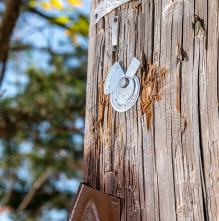Attention Cooperatives: Wood Pole Restoration Now Eligible for RUS Funding, Capital Spend

In addition to wood pole restoration systems being considered a capital investment, RUS borrowers now may also include pole restoration in their Construction Work Plans (CWPs) and/or CWP amendments. Pole restoration labor and materials are eligible for inclusion in a CWP and loan application.
The RUS Coding Guide has been updated to include RUS Code 618 – Pole Restoration. The coding guide also provides additional details on what is considered restoration versus maintenance. This will provide flexibility to RUS borrowers who choose to use this process to extend the life of the poles on their T & D system.
- Pole Restoration/Pole Banding is an eligible item for RUS Financing in the RUS Coding Guide as RUS Code 618 – Pole Restoration
- Pole Restoration/Pole Banding is an eligible item for capitalization under USOA, account 364-Poles, Towers and Fixtures
For additional guidance and verification, email RUSElectric@usda.gov or visit www.osmose.com/RUSPR.
When compared to investor-owned utilities, pole restoration has historically been underutilized by cooperative utilities. Often a lack of knowledge about this solution as an effective alternative to pole replacement, its proven longevity, and its significant financial benefits are to blame for this underutilization. With the newly updated RUS guidance and ruling concerning pole restoration and CWP’s, implementation of pole restoration programs should be given serious consideration by cooperative utilities for the benefit of its members.
These benefits include financial savings, reduced environmental impact, time and work force savings, and enhanced system resiliency.
Financial Benefits
Osmose has restored more than 1.5 million wood poles nationwide saving utilities over $3 billion compared to pole replacement. It pays to restore versus replace with the average distribution pole replacement costing $2,500 or more. However, the average cost to restore a pole is only $700. That equates to immediate savings of at least $180,000 for restoring 100 poles. Cooperatives can potentially fund all or a large part of their inspection and treatment programs with the cost savings generated from restoration.
| Program Cost WITHOUT Restoration | ||||||
|---|---|---|---|---|---|---|
| Poles Inspected | Cost to Inspect and Treat ($45 each) |
Reject Rate | Rejects | Cost to Replace ($2,500 each) |
Total Program Cost | |
| 5,000 | $225,000 | 8% | 400 | $1,000,000 | $1,225,000 | |
| Program Cost WITH Restoration | ||||||
| Poles Inspected | Cost to Inspect and Treat ($45 each) |
Reject Rate | Rejects | Restore 70% ($700 each) |
Replace 30% $2,500 each) |
Total Program Cost |
| 5,000 | $225,000 | 8% | 400 | $196,000 | $300,000 | $721,000 |
| Total Savings: $504,000 | ||||||
Environmental Benefits
- Save trees: A 2,000 square foot home can be built for every 41 poles that are kept in service
- Reduced chemical use: A typical distribution pole contains 6.4 pounds of penta and 128 pounds of fuel oil
- Reduced carbon footprint: Avoiding the harvest of 220 trees offsets the emissions from one car for one year
- Reduced landfill use: From reducing poles being replaced
Time and Work Force Savings
Not only does pole restoration help free up qualified linemen to execute other valuable tasks, but other resources are positively impacted as well. Reduced use of trucks and equipment, less engineering and staking time needed for pole replacements, less coordination with third party attachers to deal with transfers and double wood pole removal; these are all additional benefits of pole restoration and allow you to mitigate risk sooner.
Resiliency Benefits
Osmose trussing systems also act as a system hardening solution by improving the structure’s resilience to extreme weather events. Without the restored strength the truss provides, the overall circuit is at greater risk of an outage due to high winds. Getting the most weakened poles addressed with an Osmose truss will help minimize the number of wood poles needing attention when utility crews work to restore power to the grid after a significant weather event.
Osmose Pole Restoration Services
Osmose has been a trusted name in utilities services since 1934. As a world leader in wood pole inspection and restoration, Osmose technicians are experts at evaluating a pole’s remaining strength and suitability for restoration. This includes using preservatives to control decay and protect the remaining serviceable wood to ensure the longevity of the newly restored pole and the overall integrity of your pole plant.
For more information about Osmose pole restoration services, contact your local Osmose professional or email poleinfo@osmose.com.